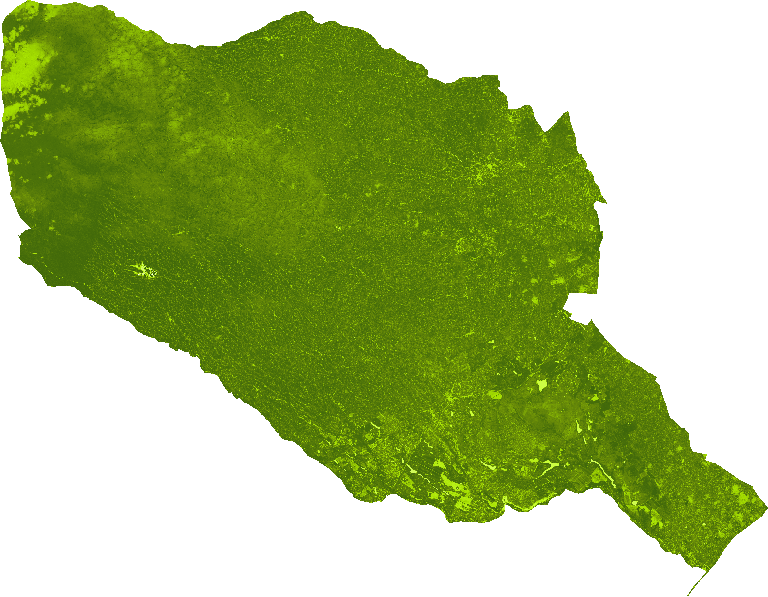Muranga_20240422__Arvi
Arvi: Atmospherically Resistant Vegetation Index: This index takes advantage of the different scattering responses from the blue and red band to retrieve information regarding the atmosphere opacity. The Atmospherically Resistant Vegetation Index algorithm was introduced by Kaufman and Tanre (1992).
The resistance of the ARVI to atmospheric effects (in comparison to the NDVI) is accomplished by a self-correction process for the atmospheric effect on the red channel.
This is done using the difference in the radiance between the blue and the red channels to correct the radiance in the red channel.
Compared to the red band, the blue band is much more easily scattered by the atmosphere particles. This explains why the sky is usually perceived as being blue.
Thus, the ARVI index takes advantage of the different scattering responses from the blue and red band to retrieve information regarding the atmosphere opacity.
Simulations using radiative transfer computations on arithmetic and natural surface spectra, for various atmospheric conditions, show that ARVI has a similar dynamic range to the NDVI, but is, on average, four times less sensitive to atmospheric effects than the NDVI.
The ARVI results from the following equation:ARVI = (IR_factor * near_IR - rb) / (IR_factor * near_IR + rb), where: rb = (red_factor * red) - gamma * (blue_factor * blue - red_factor * red), with gamma = 1
The main reason why the blue band is more susceptible to atmospheric scattering than the red band is because its wavelength is shorter. Generally, the shorter wavelength has stronger scattering.
It's very similar to the way sea waves behave over oceans. When a large wave strikes an object, such as a ferryboat, it is more capable of continuing on its path by going around the object. On the other hand, it is dispersed more easily when the waves are smaller in size.
Consequently, by obtaining the difference between the reflectance of the highly sensitive blue band and the less sensitive red band (blue - red), it serves like an indicator of what the atmospheric conditions were like.
Here gamma serves as a weighting function for the difference reflectance of the two bands. Various values can be chosen for it, which mainly depends on the type of aerosol size.
According to Kaufaman and Tanre's statement in 1992, it is best to select a gamma value of 1 when information on the aerosol type is not available.
Consequently, the main purpose of the above rb equation is to decrease the influence brought forth from the atmosphere, where a more accurate assessment of the value of the red reflectance can be obtained.
|
|
Citation proposal
. Muranga_20240422__Arvi. http://41.89.136.12:8080/catalogue/srv/api/records/Muranga_20240422__Arvi |
Simple
- Date ( Creation )
- 2024-04-22T12:00:00
- Edition
- First
- Presentation form
- Digital map
- Purpose
- Vegetation Monitoring
- Status
- Completed
- Maintenance and update frequency
- As needed
- Keywords ( Theme )
-
- Water Monitoring , Remote Sensing , Sentinel-2 , ARVI , Vegetation Index
- Keywords ( Place )
-
- Africa , Kenya , Muranga
- Use limitation
- No conditions apply
- Spatial representation type
- Grid
Point of contact
- Denominator
- 1250000
- Metadata language
- eng
- Character set
- UTF8
- Topic category
-
- Environment
- datasets
- Time period
- 2024-04-22T12:00:002024-04-22T12:00:00
))
- Supplemental Information
- This product was originated from remote sensing measurements. It should be validated with ground truth data.
- Reference system identifier
- WGS 1984
Spatial representation info
- Distribution format
-
- GeoTIFF (1.0 )
- OnLine resource
-
Muranga_20240422__Arvi.tif
geotiff format
- OnLine resource
-
EO4CEA Web Map Service description
EO4CEA Web Map Service description
- OnLine resource
-
Muranga_20240422__Arvi
Muranga_20240422__Arvi
- Hierarchy level
- Dataset
- Statement
- Please see the methodology for more explanations on EO based Indices on EO4CEA website (http://catalogue.eo4cea.eu/analysis-ready-data/)
gmd:MD_Metadata
- File identifier
- Muranga_20240422__Arvi XML
- Metadata language
- eng
- Character set
- UTF8
- Date stamp
- 2024-04-22T12:00:00
- Metadata standard name
- ISO 19115:2003/19139
- Metadata standard version
- 1.0
Point of contact
Overviews

Provided by

